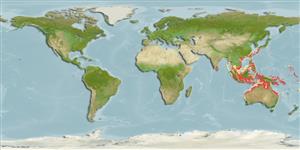>
Perciformes/Scorpaenoidei (Scorpionfishes) >
Platycephalidae (Flatheads)
Etymology: Cymbacephalus: Latin, cymba = boat + Greek, kephale = head (Ref. 45335).
Eponymy: Jules Felicien Romain Stanislas van den Bossche (1819–1889) was a Dutch colonial administrator who was Resident van Banka at the time of Bleeker’s description. [...] (Ref. 128868), visit book page.
More on author: Bleeker.
Environment: milieu / climate zone / depth range / distribution range
Ecologia
marinhas associadas(os) a recifes; não migratória; intervalo de profundidade 10 - 50 m (Ref. 90102). Tropical
Western Central Pacific: Philippines, Borneo, Singapore, Papua New Guinea, the Arafura Sea (Ref. 9819) and Western Australia to Darwin and Brisbane, Australia.
Tamanho / Peso / Idade
Maturity: Lm ? range ? - ? cm
Max length : 45.0 cm TL macho/indeterminado; (Ref. 48635); common length : 35.0 cm TL macho/indeterminado; (Ref. 9790)
Espinhos dorsais (total) : 9; Raios dorsais moles (total) : 12; Espinhos anais: 0; Raios anais moles: 12. No pit present behind upper eye. Preopercular spines short, usually 2 subequal. Infraorbital ridge usually smooth over eye. Suborbital ridge bearing 1slight spine just behind eye, spine often obscure or lacking in adults. No dermal papillae on upper eye. Caudal fin with a large elongate dark blotch along upper and lower margins.
Found in shallow coastal areas and reef flats to about 50 m. Usually captured by spear fishing or with ichthyocide, occasional specimen taken by trawling (Ref. 9790).
Life cycle and mating behavior
Maturidade | Reprodução | Desova | Ovos | Fecundidade | Larvas
Paxton, J.R., D.F. Hoese, G.R. Allen and J.E. Hanley, 1989. Pisces. Petromyzontidae to Carangidae. Zoological Catalogue of Australia, Vol. 7. Australian Government Publishing Service, Canberra, 665 p. (Ref. 7300)
Categoria na Lista Vermelha da IUCN (Ref. 130435: Version 2024-2)
Ameaça para o homem
Harmless
Utilização humana
Pescarias: pescarias de subsistência; peixe desportivo: sim
Ferramentas
Relatórios especiais
Descarregue XML
Fontes da internet
Estimates based on models
Preferred temperature (Ref.
123201): 24.5 - 29, mean 28 °C (based on 546 cells).
Phylogenetic diversity index (Ref.
82804): PD
50 = 0.5625 [Uniqueness, from 0.5 = low to 2.0 = high].
Bayesian length-weight: a=0.00457 (0.00230 - 0.00908), b=3.09 (2.91 - 3.27), in cm total length, based on LWR estimates for this (Sub)family-body shape (Ref.
93245).
Nível Trófico (Ref.
69278): 3.9 ±0.7 se; based on size and trophs of closest relatives
Resiliência (Ref.
120179): Médio, tempo mínimo de duplicação da população 1,4 - 4,4 anos (Preliminary K or Fecundity.).
Fishing Vulnerability (Ref.
59153): Low to moderate vulnerability (35 of 100).
Nutrients (Ref.
124155): Calcium = 45.6 [22.8, 113.4] mg/100g; Iron = 0.631 [0.281, 1.394] mg/100g; Protein = 17.9 [15.9, 20.0] %; Omega3 = 0.135 [0.060, 0.380] g/100g; Selenium = 36.7 [18.2, 96.3] μg/100g; VitaminA = 132 [50, 337] μg/100g; Zinc = 0.901 [0.587, 1.387] mg/100g (wet weight);
